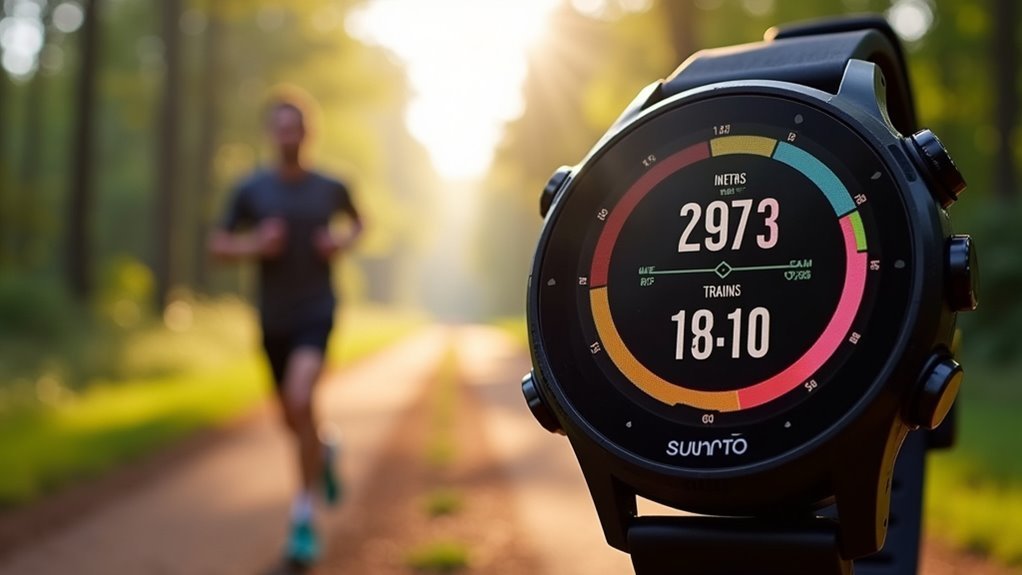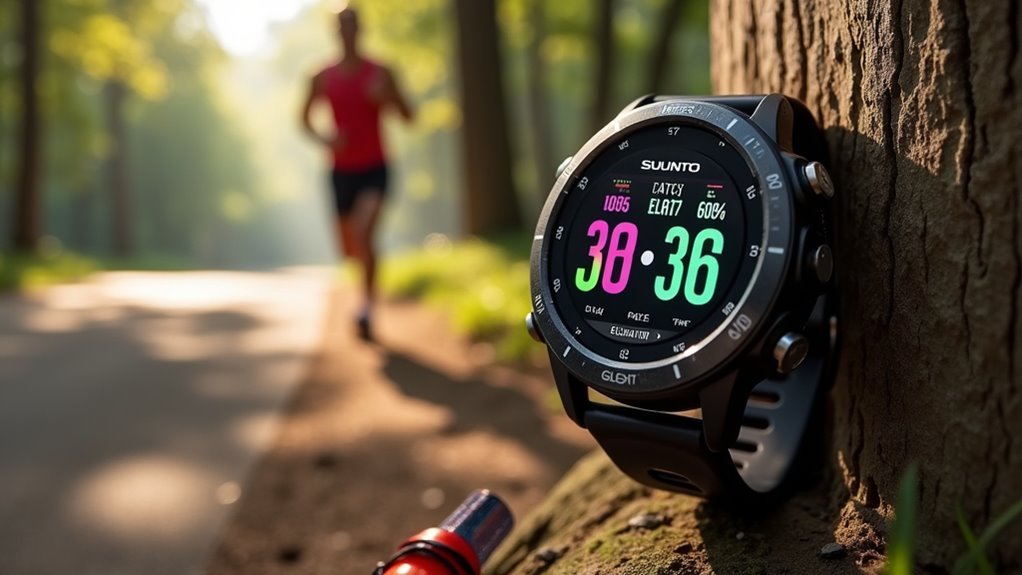You’ll maximize your running performance with Suunto’s extensive metrics including Intensity Factor (IF) for workout intensity monitoring, Training Stress Score (TSS) for quantifying session demands, and Chronic Training Load (CTL) for tracking long-term fitness trends. The watch optimizes your cadence through real-time feedback, delivers precise GPS-based pace tracking with terrain adjustments, and monitors advanced biomechanical data like ground contact time and leg spring stiffness. These integrated metrics provide the strategic insights that’ll elevate your training to elite levels.
Understanding Intensity Factor and Training Zone Classifications

Every serious runner needs a reliable way to measure workout intensity, and that’s where Intensity Factor (IF) becomes invaluable. IF calculates the ratio of your Normalized Power to your Functional Threshold Power, giving you a straightforward measure of how hard you’re working during each session.
Understanding typical IF values helps you train smarter. Recovery sessions should stay below 0.75, while endurance training ranges from 0.75 to 0.85. Tempo workouts push you to 0.85-0.95, and threshold intervals demand 0.95-1.05. Short time trials can reach 1.05-1.15.
Your Suunto watch organizes these intensities into training zones. Zone 1-2 covers recovery, Zone 3 handles endurance, Zone 4 targets tempo work, and Zone 5 focuses on threshold training. The metrics-based approach helps you avoid repetitive training cycles that don’t deliver meaningful improvements.
This classification system makes tracking your training intensity effortless.
Training Load Monitoring and Long-Term Performance Analysis
Consistency separates good runners from great ones, and that’s where Training Load Monitoring becomes your secret weapon for long-term success.
Your Chronic Training Load (CTL) tracks accumulated fitness over weeks and months, showing real aerobic improvements from sustained effort. Meanwhile, Acute Training Load (ATL) monitors recent fatigue levels, helping you balance hard work with recovery.
Your Training Stress Score (TSS) quantifies each workout’s intensity and duration into actionable data.
Suunto’s Progress widget reveals patterns in your CTL, VO₂max trends, and ramp rates over months. When your Form shows CTL exceeding ATL, you’re building fitness smartly. Negative Form signals excessive fatigue requiring rest. The weekly view covers the last 26 weeks while the daily view spans 41 days, allowing you to analyze both short-term patterns and medium-term trends.
This systematic approach prevents overtraining while maximizing adaptations, transforming scattered workouts into purposeful progression toward your running goals.
Cadence Optimization for Running Efficiency

While training load metrics reveal when and how hard to train, your running cadence determines how efficiently you move with each step. Most recreational runners operate 3–5% below their best cadence, increasing energy expenditure by 2–4% over long distances. This seemingly small difference adds approximately 4.2 mL·kg⁻¹·min⁻¹ to your oxygen consumption.
The widely cited 180 steps per minute benchmark isn’t universally best—elite runners range from 155 to 203 spm. Your ideal cadence depends on height, leg length, and running style. Higher cadence reduces ground contact time, minimizes overstriding, and decreases peak impact forces by reducing braking forces on joints.
Research shows that cadence naturally increases by 4-5 steps per minute for each mile of increased speed, contradicting the traditional belief that optimal cadence remains constant across different paces. Start enhancing by increasing your current cadence 5–10% gradually during easy runs, maintaining constant pace while monitoring comfort and efficiency.
GPS-Based Pace and Distance Tracking
Your Suunto’s wrist-based GPS technology delivers precise location tracking that rivals dedicated GPS units, giving you confidence in your distance measurements whether you’re running city streets or mountain trails.
You’ll receive real-time pace data that updates continuously, allowing you to adjust your effort instantly to maintain your target pace zones throughout your workout.
After each run, you can analyze detailed distance breakdowns that show exactly how your pacing varied across different segments of your route, helping you identify patterns in your performance. The GPS data automatically accounts for terrain variations like hills, providing normalized graded pace that reflects the true intensity of your workout regardless of elevation changes.
Wrist-Based GPS Accuracy
GPS accuracy represents one of the most critical aspects of distance tracking for runners using Suunto watches. Your Suunto device tends to overstate distances, particularly in GPS-challenged environments like urban canyons or dense forests.
Unlike Garmin watches that rely on cadence and stride length when GPS signals weaken, Suunto prioritizes consistent pace and speed data through algorithmic adjustments.
To optimize your GPS accuracy, consider these techniques:
- Set GPS accuracy to “Best” for higher frequency positioning fixes
- Use “Performance” battery mode to maximize GPS tracking precision
- Position your watch properly on your wrist for better signal reception
- Keep firmware updated to benefit from the latest accuracy improvements
Despite distance discrepancies, your Suunto provides reliable pace data and integrates well with digital mapping software. Testing on certified courses shows Suunto devices can achieve high accuracy when properly calibrated.
Real-Time Pace Data
Real-time pace feedback transforms your running experience by delivering instant speed calculations through satellite positioning technology.
You’ll receive accurate distance and pace measurements that help you maintain ideal intensity throughout your workout. Suunto’s normalized graded pace feature adjusts for terrain difficulties, giving you comparable data across different routes.
You can customize your display to show pace alongside heart rate, cadence, and climb metrics for extensive performance monitoring.
This integration enables zone-based training, allowing you to stay within specific intensity targets while preventing overtraining through fatigue detection. However, current pace readings may experience inaccuracies due to satellite connection problems that can affect real-time data reliability.
The real-time adjustments help you develop personalized training strategies and improve running efficiency.
Your pace data contributes to training load analysis, supporting better recovery planning and performance enhancement for competitions.
Post-Run Distance Analysis
Three advanced technologies combine to deliver Suunto’s most precise post-run distance analysis: dual-band GPS, motion sensor integration, and the proprietary FusedTrack™ algorithm.
You’ll experience reliable tracking even when GPS signals weaken in urban environments or under tree cover. The durable construction ensures consistent performance across challenging conditions and extended training periods.
Your post-run data automatically syncs to the Suunto app, where you can dive deep into performance metrics:
- Detailed pace zone breakdowns with split analysis for every segment
- Elevation and ascent data integrated seamlessly with GPS tracking
- Comparative analysis against previous runs and training goals
- Training load insights derived from thorough distance measurements
You can export this data to third-party platforms like Strava, enabling data-driven adjustments for future training plans and race preparation strategies.
Advanced Biomechanical Running Form Metrics
Your running form’s efficiency hinges on two critical biomechanical metrics that Suunto tracks with precision.
Leg spring stiffness analysis reveals how effectively you’re converting elastic energy into forward propulsion, while ground contact optimization shows whether you’re spending too much time planted on the ground with each stride.
These advanced metrics transform raw data into actionable insights that’ll help you run faster and reduce your injury risk. Monitoring your vertical oscillation helps minimize wasted energy from excessive upward and downward movement during each stride.
Leg Spring Stiffness Analysis
When you’re running, your leg functions as a sophisticated spring system that compresses upon ground contact and rebounds to propel you forward.
Leg Spring Stiffness (LSS) measures your leg’s resistance to deformation under load, helping you understand how efficiently you store and release elastic energy during each stride.
LSS isn’t about muscle tightness—it’s a biomechanical property based on the Spring-Mass Model that analyzes how your muscles, tendons, and ligaments work together. This balance between absorption and propulsion determines the effectiveness of your running mechanics.
Several factors influence your LSS:
- Running speed – Faster paces typically increase stiffness requirements
- Body weight and load – Additional weight proportionally raises LSS
- Training adaptations – Plyometric and strength work enhance stiffness
- Ground reaction forces – Higher impact demands greater resistance
Optimizing your LSS improves running economy and potentially reduces injury risk.
Ground Contact Optimization
Although your leg’s spring-like properties determine energy storage and release, ground contact time reveals how efficiently you transfer that energy to forward propulsion.
You’ll find that shorter contact times typically indicate better running economy, as elite runners spend less time on the ground per step.
Your running style greatly impacts this metric. Midfoot striking generally produces shorter contact times than heel striking, while faster speeds and higher cadences naturally reduce ground contact duration.
Terrain also matters—softer surfaces increase contact time compared to firm ground.
To optimize your ground contact time, focus on quick turnover drills and interval training. Research shows that trained runners naturally self-select ground contact times within 5% of their mathematically optimal values for best metabolic efficiency. Real-time feedback devices help you monitor improvements during workouts.
Elevation and Terrain-Adjusted Performance Measurements

Since elevation changes dramatically impact your running performance, Suunto’s terrain-adjusted metrics provide a more accurate picture of your effort than traditional pace and heart rate alone.
Elevation changes demand more from your body than flat terrain, making traditional metrics insufficient for measuring true running effort.
Your Suunto watch automatically adjusts performance evaluations based on elevation gain and terrain difficulty, helping you understand the true physical demands of your runs.
Here’s how elevation enhances your training insights:
- Barometric Precision – Suunto watches with barometric sensors deliver more stable altitude measurements than GPS-only devices.
- FusedAlti Technology – Combines GPS and barometric data to minimize temporary errors and offset issues.
- Terrain-Adjusted Zones – Your training zones adapt dynamically for uphill and downhill segments.
- 3D Route Planning – Visualize vertical challenges before running using the Suunto app’s topographic maps.
You’ll receive real-time elevation profiles and post-run vertical gain data for smarter training decisions. Running power reacts quicker than heart rate measurements, making it particularly valuable for analyzing your effort during rapid elevation changes and technical trail sections.
Real-Time Data Integration With Third-Party Platforms
Beyond tracking metrics from your watch alone, Suunto devices excel at integrating real-time data from advanced third-party sensors and platforms during your runs.
You’ll receive immediate feedback on running power, leg spring stiffness, vertical oscillation, and ground contact time through sensors like Stryd. The SuuntoPlus sport apps automatically connect to compatible sensors before your workout starts, displaying live metrics you can access by swiping left or using your watch’s middle button.
Your captured data syncs seamlessly with platforms like TrainingPeaks and Strava after each run, enabling detailed post-activity analysis. The CORE body temperature sensor integration provides additional physiological insights that enhance your training effectiveness with real-time data during workouts.
Suunto’s API facilitates automatic workout transfers between platforms, though some limitations exist. You’ll find that third-party apps manage data streaming direction, bridging gaps where direct imports aren’t supported.
Strategic Application of Metrics for Training Optimization
While collecting data represents only the first step in performance enhancement, transforming Suunto’s metrics into actionable training adjustments separates elite athletes from recreational runners.
You’ll maximize your training productivity by applying these strategic approaches:
- Vary intensity zones based on your Training Stress Score data to prevent plateauing and promote continuous adaptation.
- Monitor biomechanical metrics like vertical oscillation and ground contact time to enhance running economy and reduce injury risk.
- Track six-week training load averages to guarantee progressive overload without overtraining.
- Use real-time hrTSS feedback to adjust workout intensity mid-session for ideal cardiovascular stimulus.
Post-activity analysis of heart rate, power, and pace data enables targeted tweaks that improve both endurance and speed, preventing autopilot training habits that limit performance gains. The Suunto app’s long-term analysis powered by TrainingPeaks provides comprehensive insights that help identify patterns and trends across multiple training cycles.
Frequently Asked Questions
How Accurate Is Suunto’s Wrist-Based Heart Rate Monitoring During High-Intensity Intervals?
During high-intensity intervals, you’ll find Suunto’s wrist-based heart rate accuracy decreases considerably. You’ll experience missed peaks, cadence lock issues, and erratic readings due to increased movement and sweat interfering with sensors.
Can Suunto Watches Track Running Metrics in Poor GPS Conditions or Indoors?
You can track running metrics indoors using Suunto’s accelerometer and additional sensors. The dual-frequency GPS chipset helps in poor conditions, though accuracy may decrease in challenging terrain or tunnels.
What’s the Battery Life Impact When Using All Advanced Running Metrics Simultaneously?
Using all advanced running metrics simultaneously cuts your battery life by 20-40% compared to basic modes. You’ll get roughly 24-32 hours instead of 40 hours on most Suunto models.
How Does Suunto’s Metric Accuracy Compare to Dedicated Foot Pods or Chest Straps?
You’ll find Suunto’s wrist-based metrics less accurate than dedicated accessories. Chest straps deliver superior heart rate data, while foot pods provide more precise stride length, cadence, and running dynamics compared to Suunto’s optical sensors.
Which Suunto Watch Models Support All the Advanced Biomechanical Running Form Metrics?
You’ll need external sensors like Stryd for advanced biomechanical metrics, as Suunto watches don’t natively support detailed running form analysis. The Suunto 9 Peak and Race support Bluetooth connectivity for pairing these accessories.
In Summary
You’ll maximize your running performance by leveraging Suunto’s extensive metrics suite. Focus on intensity factor data to optimize your training zones, monitor cadence for efficiency gains, and use biomechanical insights to refine your form. Don’t overlook elevation adjustments and long-term load analysis for strategic planning. Integrate real-time data with your preferred platforms to create a seamless training ecosystem that’ll drive consistent improvement and help you reach your athletic goals.





Leave a Reply